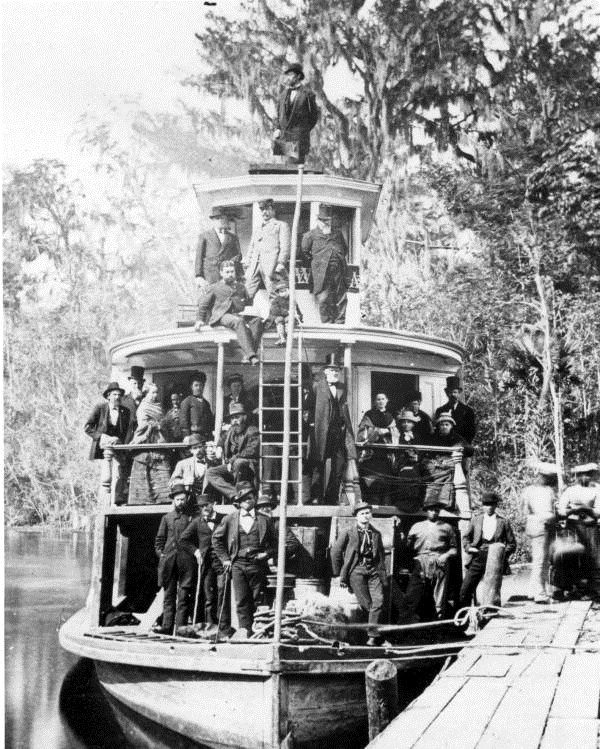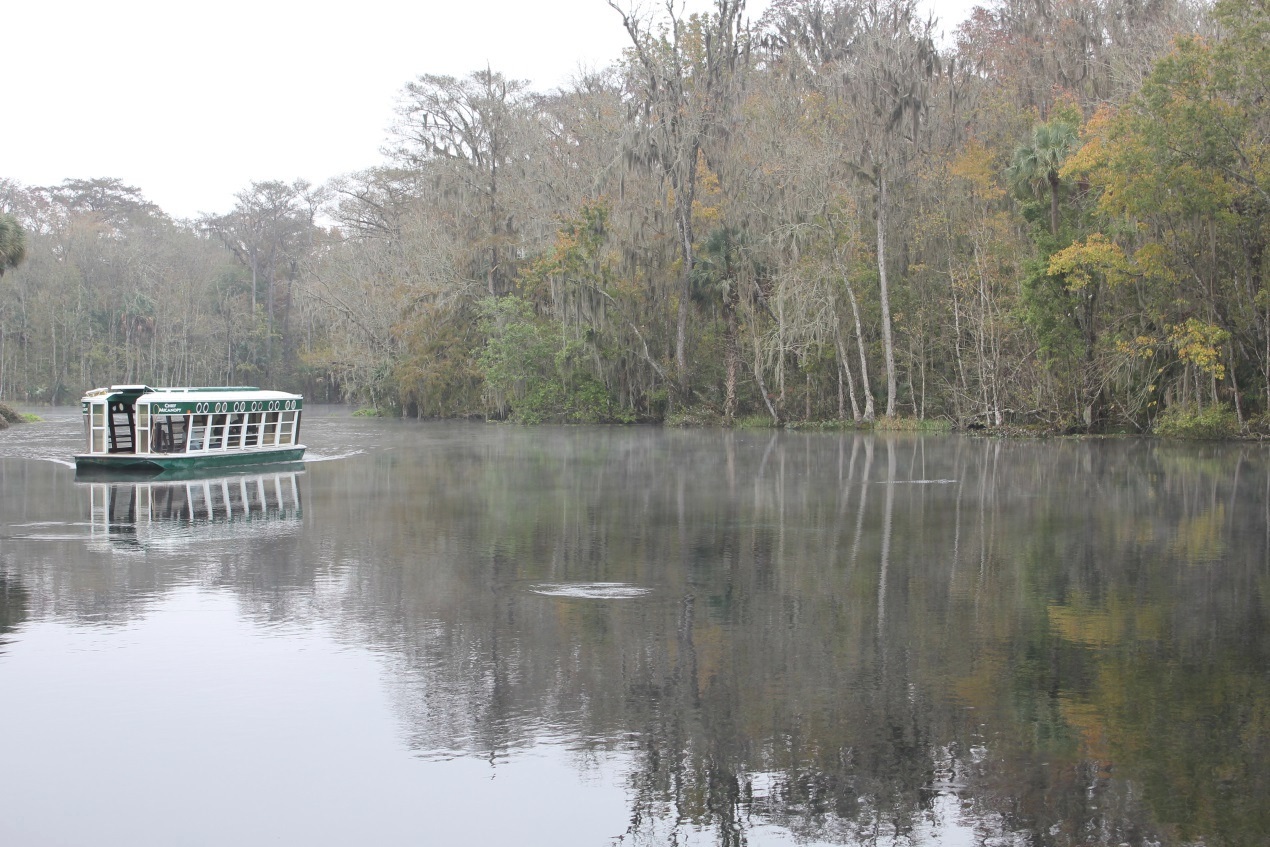Environmentalists, scientists, politicians, ranchers, and citizens square off over a water withdrawal permit for a 25,000 acre ranch just 5 miles north of an ice-age natural landmark, Silver Springs.
A once-pristine spring in Ocala, Florida is at the center of a battle between environmentalists and a billionaire Canadian businessman. Frank Stronach wants to pump 5 million gallons per day (mgd) out of the aquifer to water a proposed cattle ranch and slaughterhouse. He claims the ranch will produce beef that is leaner and healthier than most and create lots of badly needed jobs. But environmentalists say healthy beef and jobs aren’t enough to make up for the drain on the state’s already-pressured water supply, and they point to Silver Springs as an example.
Silver Springs has long been known for its clear water, sandy bottom, and large variety of fish. It’s one of the largest springs in Florida, pumping more than 530 million gallons a day of water from the Floridan aquifer, the limestone structure that underlies and provides drinking water to Florida and parts of Alabama, Georgia, and the Carolinas. But today a passenger on its famous glass-bottom boat ride will have to look hard to see the sandy bottom. It’s covered with brown algae and the schools of fish are down to just a few species, here and there. What isn’t visible is the reduced flow of water coming up through the spring “vents,” or the increased nitrogen from livestock runoff, wastewater discharge, and sewer tank leakage, according to the Florida Department of Environmental Protection. All of this means that Silver Springs, which got its name because the snow-white sand and iridescent blue-green limestone rocks that cast a silver hue to the springs, is now cloudy and brown.
The rapid decline in the springs surprises many Floridians and visitors. “When you think of ecological change, you think of glaciers,” said gubernatorial candidate and former state Senator Nan Rich, on a tour of the springs recently. “Then you get out and see these springs compared to photographs from just a few years ago, and it hits you: it’s such a short period of time.”
Two-Lane Roads and Four-Board Fences
Silver Springs is in Marion County, a rural county with 300,000 residents, two-lane roads and rolling pastures. Known internationally for its horse breeding industry, the only traffic congestion is around the entrance to Silver Springs and in the typical chain store sprawl that surrounds the quaint downtown. Despite the chains, there are lots of mom-and-pop diners and motels from the 1950s with names like “Silver Palm Motor Court” and “Stage Coach Inn” to remind you that this tourist attraction didn’t spring up overnight. In fact, Silver Springs is Florida’s oldest attraction, dating to the early 1800’s. In the twentieth century, movies and television shows like “The Creature From the Black Lagoon,” “Seahunt,” and “Tarzan” were filmed here. But archaeological evidence goes much farther back, 12,000 years ago when Paleo-Indians lived in the area, and giant mastodons and mammoths drank from the springs.
But Florida’s explosive growth in the last few decades has mostly passed Marion County by, despite an estimated 1 million visitors a year to Silver Springs, according to an FDEP report. That leaves county commissioners struggling to ease the county’s 10.8% unemployment rate. When Stronach proposed a ranch that he claimed would employ 150 skilled workers and provide the area’s only slaughterhouse, it sounded good to former commissioner Charlie Stone, who said in an interview posted on YouTube, “It’s all about the jobs.” (Spokespeople for the current county commission did not return calls or emails for comment.)
The Florida Cattleman’s Association also thought Stronach’s plan looked like a good deal – a spokesperson said Stronach would likely buy calves from area cattlemen. Plus, the cattlemen could use the slaughterhouse, instead of the current practice of shipping cattle out of the area for slaughter.
Adena Springs Ranch would be unique in Marion County, and Stronach has invested a lot of money in the planning stage. He hired “hydrologists and modelers and ecologists” to study the water withdrawal permit and their findings showed that, even though the ranch is within the “springshed,” (the area that ultimately seeps into groundwater around Silver Springs), pumping groundwater will have no effect on the levels of the aquifer. Besides, the ranch claims they will only irrigate when rainfall is down, according to its website.
Stronach’s plan is to group the cattle by age and move them from the south end of the ranch to the north during their lifetime, ending at the slaughterhouse. They will be solely grass-fed, unlike most Florida cattle, which are shipped west to be fattened on grain and corn before slaughter. Rain will irrigate the grass, except in times of drought, and the cow manure will provide the only fertilizer. They will hire certified agronomists to test the soil every two weeks to make sure there isn’t too much nitrogen seeping into the soil. Ranch General Manager Mark Roberts, said in a presentation posted on YouTube, “Our hopes are to create a facility that will be used as a model throughout the country, as the demand for locally grown products and humane treatment of animals grows. We think this is the future.”
What’s the Beef?
Local jobs, local, healthy beef, and environmental self-monitoring – so why the uproar? For one thing, said Guy Marwick, director of the conservation group The Felburn Foundation, FDEP was recently charged under the federal Clean Water Act with improving the health of the springs by reducing the nitrates in the water by 79%. An FDEP report says that agricultural runoff is one of the primary causes of nitrogen overload. “A small percentage of nitrate leaching from improperly stored manure can contribute to a significant load of nitrate to ground water and receiving springs,” says the report.
“That’s why Adena is a problem,” said Marwick. But all the environmentalists interviewed believe the permit will be issued, because, as Marwick said, the water management districts “never say no.”
Hank Largin, a spokesman for the St. Johns River Water Management District (SJRWMD), disagrees. ““People say the governing board approves everything, but by the time the permit reaches the board, SJRWMD staff has been working with the user for months or even years,” and “a lot has been worked out.” He points to the fact that Adena Springs’ initial request for 23 mgd was reduced to 13 mgd, and is now down to 5 mgd as they have responded to input from the water management district. Largin said that final approval lies with the district governing board, who are political appointees, in this case, of Governor Rick Scott. Scott’s cutting of environmental funding and aggressive pursuit of jobs, according to environmentalists, is what has them worried.
Still, Largin understands why the issue is so contentious. ““In Marion County, Silver Springs is one of the iconic springs in Florida. Throughout the years there has been a decrease in spring-flow, and some people believe it’s from pumping water out of the aquifer. We don’t. We believe it’s a result of reduced rain-flow,” a position also shared by consultants to Adena Springs Ranch.
But a local scientist with more than three decades of industry experience disagrees. “All water withdrawals impact the aquifer,” he said. As for Adena Springs claim it will only pump water when it’s not raining, the scientist, who asked not to be named because his employer has customers on both sides of the issue, said, “But that’s when we all need the water.” He further said that the aquifer and springs are “a complex, complicated system with a big springshed.” He’d like to see a team of scientists undertake a study of Florida’s water and have their findings peer-reviewed, as is done in the medical industry. Otherwise it’s important to know who a scientist is working for. “I’m not prepared to make a monster out of Adena Springs,” he said. “Maybe they will show us a sustainable model. But ultimately, It’s up to the people to decide what the most beneficial use of our water is, and for me, it’s always going to be for drinking.”
But maybe some of the problem is suspicion of Stronach himself. He sold the company he built, auto parts manufacturer Magma International, for $1 billion, according to Canada’s “The Globe and Daily Mail.” Over the years, he’s also been involved in horse breeding and racing, owning several racetracks throughout the country. He owns large tracts of land throughout the United States, in addition to the 25,000 acres in Marion County and 35,000 acres in Levy County. In northern Marion County, he has developed a 1,000 acre golf course subdivision. Recently, Stronach went back to his home country of Austria and formed a political party to try to get Austria out of the Euro, picking up 11 seats in the last election. And now, the 81-year-old Stronach wants to be a Florida rancher, despite living in both Austria and Ontario, Canada. He has invested money in Florida, donating $1.5 million to the University of Florida Extension Service to build a new facility – with his name on it. That kind of cash makes environmentalists and some citizens nervous.
The scientist added that it may be time to look at the whole permitting process, which hasn’t been updated in decades. “We are in a drought, and we’re still pumping out water. It’s not a sustainable system.”
On Tuesday, December 11, 2013, Adena Springs Ranch requested another time extension to supply SJRWMD with additional information. The extension was granted until March 13, 2014. Ranch representatives could not be reached for comment.
(This article was first published in the Charles River Review, literary journal of Harvard University Extension School.)




Leave a Reply